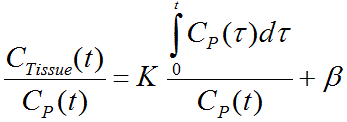In 2009 Zhou et al. introduced a new graphical method [60]. It can be applied with a plasma input curve for the calculation of the distribution volume, and with a reference tissue curve for the calculation of the binding potential. The equation of the graphical plot called "RE plot" (for Relative Equilibrium) is given by

For the RE plot to be applicable there must exist a time t* after which two conditions are fulfilled:
Under these conditions the tracer in all tissue compartments reaches equilibrium relative to plasma. Note that the conditions must be verified explicitly, because the linear appearance of the RE plot is not a sufficient criterion.
It was shown with Raclopride data and with simulations, that unlike the Logan plot the RE plot is not suffering from bias due to high noise levels. As a consequence, the results obtained with VOI-averaged TACs is consistent to the results obtained in pixel-wise applications. However, it was found that violation of the relative equilibrium condition did introduce bias. To compensate this bias Zhou et al [61] combined the RE plot with the Patlak plot in the following bi-graphical manner which is called the RE-GP Analysis:
The same data is analyzed with the RE plot above and the Patlak plot,

using the same t* for fitting two respective regression lines. A consistent and unbiased distribution volume is then obtained by combining the slopes and intercepts of the two plots:

For the pixel-wise application of the RE-GP Analysis the results of the Patlak plot are smoothed, so that the calculation turns into

where Ks and bs are obtained from spatially smoothed maps of K and b.
Implementation Notes
The RE-GP Analysis model calculates and displays the measurements transformed as described by the RE plot formula above. It allows fitting a regression line using the data points after a time t*. Note that t* must be specified in real acquisition time, although the x-axis units are in "normalized time". The corresponding normalized time which can be looked up in the plot is shown as a non-fitable result parameter Start.
If t* is changed to define a new data segment, the program finds the closest acquisition start time, fits the two regression lines to the RE plot and the Patlak plot, and updates the calculated parameters. The main outcome is the distribution volumes calculated with the RE-GP analysis (Vt-REGP). For a comparison, Vt calculated with the RE plot alone (Vt-RE) is also shown.
Per default, only the curves of the RE plot and its regression line are shown in the curve area. However, the Patlak plot and its regression line can also be visualized by enabling their boxes in the curve control area. Note that the values of the Patlak plot may have a very different dynamic range than the RE plot. Therefore it is recommended switching off the RE curves when switching on the Patlak ones.
RE-GP Plot Publication, Abstract [61]
"In quantitative dynamic PET studies, graphical analysis methods including the Gjedde–Patlak plot, the Logan plot, and the relative equilibrium-based graphical plot (RE plot) (Zhou Y., Ye W., Brašić J.R., Crabb A.H., Hilton J., Wong D.F. 2009. A consistent and efficient graphical analysis method to improve the quantification of reversible tracer binding in radioligand receptor dynamic PET studies. Neuroimage 44(3):661–670) are based on the theory of a compartmental model with assumptions on tissue tracer kinetics. If those assumptions are violated, then the resulting estimates may be biased. In this study, a multi-graphical analysis method was developed to characterize the non-relative equilibrium effects on the estimates of total distribution volume (Vt) from the RE plot. A novel bi-graphical analysis method using the RE plot with the Gjedde–Patlak plot (RE-GP plots) was proposed to estimate Vt for the quantification of reversible tracer kinetics that may not be at relative equilibrium states during PET study period. The RE-GP plots and the Logan plot were evaluated by 19 [11C]WIN35,428 and 10 [11C]MDL100,907 normal human dynamic PET studies with brain tissue tracer kinetics measured at both region of interest (ROI) and pixel levels. A 2-tissue compartment model (2TCM) was used to fit ROI time activity curves (TACs). By applying multi-graphical plots to the 2TCM fitted ROI TACs which were considered as the noise-free tracer kinetics, the estimates of Vt from the RE-GP plots, the Logan plot, and the 2TCM fitting were equal to each other. For the measured ROI TACs, there was no significant difference between the estimates of the Vt from the RE-GP plots and those from 2TCM fitting (p=0.77), but the estimates of the DVT from the Logan plot were significantly (p <0.001) lower, 2.3% on average, than those from 2TCM fitting. There was a highly linear correlation between the ROI DVT from the parametric images (Y) and those from the ROI kinetics (X) by using the RE-GP plots (Y=1.01X+0.23, R2=0.99). For the Logan plot, the ROI estimates from the parametric images were 13% to 83% lower than those from ROI kinetics. The computational time for generating parametric images was reduced by 69% on average by the RE-GP plots in contrast to the Logan plot. In conclusion, the bigraphical analysis method using the RE-GP plots was a reliable, robust and computationally efficient kinetic modeling approach to improve the quantification of dynamic PET."